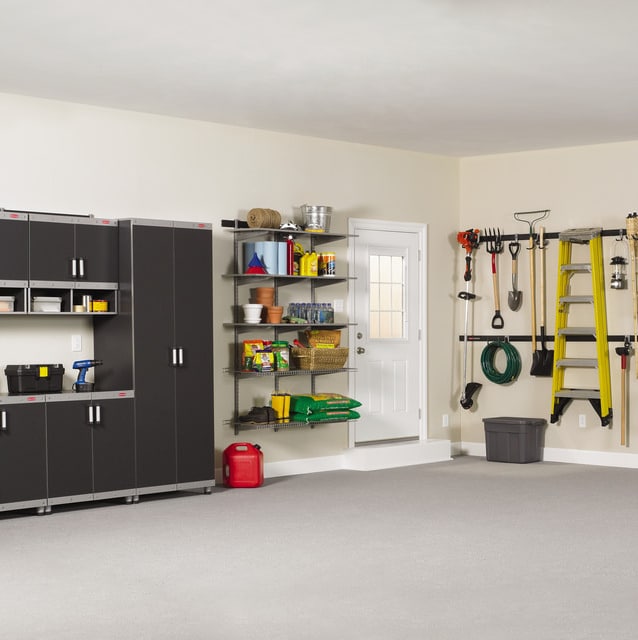If you’re getting ready to sell your home, you’re probably developing a master project list based on a number of questions and decisions: What needs fixing? What needs freshening up? Where will you spend your money before putting your home on the market? And what return will you get on that investment?
We all know that kitchens and bathrooms sit at the top of the list of smart investments when it comes to your home’s value. Fresh paint and outdoor upgrades are also quick fixes that add appeal.
But did you know that a garage remodel should also be on your radar? Angie’s List says that, on average, you can expect to get about 60% of your investment back on a garage remodel. In fact, simply replacing your garage door can return 90% of the cost back to you when you sell.
Angie Hicks, founder of Angie’s List writes: “Of all the spaces in our homes, the garage is perhaps the most underutilized. And it’s an area that offers endless opportunities for enhanced curb appeal, improved organization, and even remodeling.”
Angie’s List just published their monthly magazine — and it’s all about garages! So before you finalize your pre-sale project list, we think you might want to check it out.
The Garage Issue delivers great ideas for improving your garage’s functionality, appearance, and safety — all of which buyers will notice. Here are a few highlights from the issue. You can read it in its entirety on >Angie’s List’s website.
Start With a Good Plan
Planning is essential for any home project, including a garage remodel. Here are a few tips Angie’s List provides:
- Think it through. Take the planning process seriously. Prioritize your needs and wants up-front. Consider what you want to use the space for if you’re not selling. And think about your potential buyer if you are.
- Be realistic. A garage remodel can cost thousands or even tens of thousands. Make sure you know what you’re getting for the money you spend.
- Consider the logistics. Don’t overlook planning for temperature control, lighting, electricity, and running water. Your buyer’s home inspector will be looking at these items closely.
Prioritize Replacing Your Garage Door
As mentioned earlier, a garage door replacement is a good investment because of its high return. But there are a few decisions you’ll need to make before tackling this project:
- What material to use? Four of the most common choices for garage door materials are wood, steel, aluminum, and composite. Each has its pros and cons in terms of appearance, durability, insulation, and price. The Garage Issue helps you compare them.
- Insulated or non-insulated? Insulated garage doors have a foam injection or exterior panel the reduces heat loss. (One garage door supplier claims an energy-efficient garage door can reduce energy loss by 71%.) They are sturdier than non-insulated doors. And they offer better durability, noise reduction, and security. They come at a higher cost, however. And they’re heavier, so you’ll need to make sure the hardware, opener, and springs can handle that weight. Your garage door specialist should be able to discuss the pros and cons of insulation.
- What garage door opener to buy? There are three primary styles: chain-drive, belt-drive, and screw-drive. Chain-drive openers are economical but noisy. A belt-drive opener is quiet and durable, but more expensive than chain-drive models. Screw-drive openers are somewhat noisy and fall in the middle price-wise. Smart garage door openers (that can be accessed from your mobile device or computer) are also becoming popular. So make sure you understand all your choices.
Organization Counts
The garage can be a very useful space, but when it’s disorganized, its usefulness decreases. Potential home buyers will be attracted to a well-organized garage and turned off by one that is in disarray. Angie’s List provides seven steps to an organized garage:
- Think like an organizer. Go through the items currently living in your garage. Get rid of what you can and categorize the rest.
- Put safety first. Store hazardous items, like paints, cleaners, and yard chemicals safely. And dispose of them properly when you decide to get rid of them.
- Maximize wall space. Hang what you can to free up floor space. You have many organizers to choose from on the market, but make sure they are hung on studs for security.
- Prioritize by size. Figure out where the big stuff — lawnmowers, cars, freezers, etc. — will go first. Then find ways to fit other items in the space left over.
- Raise the roof. Ceiling-mounted storage units, hanging shelves, or overhead lofts take your garage storage to the next level. Again, there are many options on the market, but make sure they are hung properly to prevent damage or injury.
- Hire a professional organizer. Not all of us are the best at logically organizing items within a space. A professional organizer can help you declutter and create the optimal storage solutions to maximize your garage’s space.
- Spring for shelves. Deep shelves or cabinets give you room to store all the tools, equipment, and supplies you likely keep in your garage. They should be at least 24 inches deep and strong enough to hold the weight of what you want to store.
Thanks to Angie’s List for this useful publication!
Image Credit: Flickr
About Our Licensed Dallas Home Inspections
At Stonebriar Property Inspections, Dallas home inspector Keith Boggs proudly provides quality home inspections throughout North Texas seven days a week, including evenings and weekends. Contact him at (214) 923-7304 or [email protected].
- Licensed and insured – Texas Real Estate Commission license #9867. TDA licensed termite technician #0572333. PestGo Pest Control LLC TPCL #0770368
- Rated an A+ with the Dallas Better Business Bureau
- 5 out of 5 stars on 99% of customer reviews
- The most comprehensive home inspections available
- Friendly, down-to-earth service from someone you can trust





